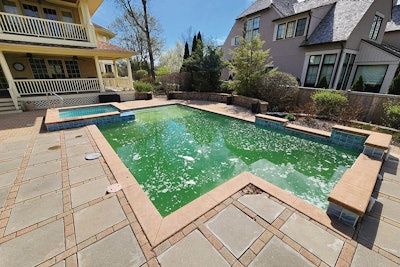
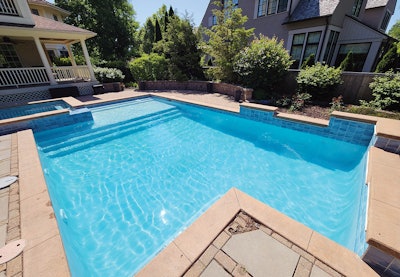
Luxury pools and jaw-dropping mosaics may be the first things that come to mind when people think of the art of swimming pools. However, forgotten or abandoned swimming pools — choked with algae and ripe with life — present a canvas waiting for Rembrandt's transformation into a shimmering oasis. Artists that work in algae remediation possess a combination of technical and chemical expertise, creativity, and meticulous attention to detail, enabling them to restore even the most neglected quagmire.
It's not just art for its own sake, guiding a pool of verdant swamp vomit and mosquito larva, Lazaruslike, back to its pure crystalline origins can be a lucrative addition to any company's service offerings. However, this is not for the faint of heart or the lightly trained. Amateur attempts can and will lead to costly failures.
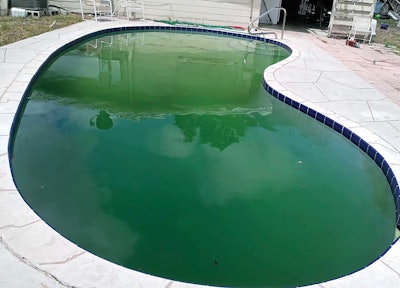
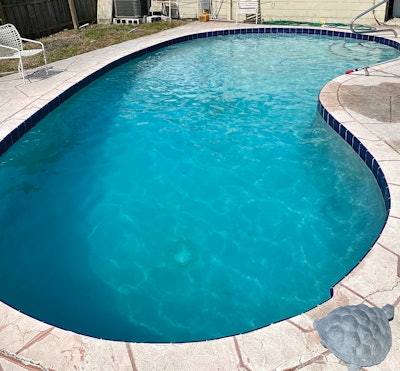
A GRUESOME DISCOVERY
I gaze down at the murky water. Is this the one I find the body in?
That is a common thought among the pool service pros tasked with remediation of a pool untouched for 10 years. It's hard to deny the obvious — this is the perfect dumping ground for John Walsh's Most Wanted Fugitive or that heist crew member that just couldn't wait to spend the money like they planned. You've thought this before, right?
Most of us who treat pools at foreclosed homes or Real Estate Owned (REO) properties are handed the nastiest of the nasties. And when wading through the knee-high grass of the Jeepers Creepers' yard, the mind starts imagining all kinds of scenarios for true crime podcasts.
We all get calls requesting pricing on swimming pools that were "clear yesterday." After all, losing sight of the pool floor doesn't take years of neglect — but it can't occur within a few days, either. In any case, these calls can provide significant financial opportunity. I wanted to share the absolute best method I know for restoring a 20,000 gallon Petri dish into a swimmable haven of relaxation and enjoyment.
YOU DO YOU!
One obvious caveat: You conduct a green-to-clean for your company using the methods that give you the most consistent and profitable results. You are the pool pro poolside.
Ideally, the service professional should avoid becoming a one-trick pony and understand that different circumstances will demand slightly or even drastically different regimens. So, it pays to develop and master a few weapons of algae destruction to keep in your arsenal; it also is wise not to overestimate your skillset because you have critical decisions to make.
A swimming pool might appear beyond redemption, leaving you with the most basic and laborious option of starting fresh with a drain and fill. There's nothing wrong with calling a do-over. That could be the safest bet if it's worse than you have ever handled. Remember, there are profits at stake, and attempting a treatment that doesn't work only to drain and fill anyway is a waste of time and money.
KILL IT WITH HALOGENS!
Good old-fashioned chlorine can often do the trick, but do not overestimate the halogen's potency. Maintaining a free chlorine level upwards of 30 parts per million for an extended period is often necessary. If a stabilizer level is present, it may be required to assist the chlorine in working around the attraction of hypochlorous acid to cyanuric acid (CYA) by adding either sodium bromide or ammonium sulfate. The addition of the bromide product to a chlorine pool will force a displacement reaction resulting in free bromine (hypobromous acid and hypobromite ion), while introducing ammonium sulfate will result in the formation of monochloramine (NH2Cl), neither of which shares free chlorine's affinity for cyanuric acid.
Suppose you believe you will need a chemical packed with more chutzpah than that. You can find a combination of ammonium sulfate and EDTA (disodium salt of ethylenediaminetetraacetic acid), C10H16N2O8. The addition of this antibacterial hospital soap in the mix not only serves as a chelating agent but dramatically reduces the ability of benthic species (floor and wall dwellers) to stick to surfaces, making them easier to dislodge and gaining 360-degree chemical exposure to their algal cells. This increases the likelihood they will be removed through filtration. Don't go buck nutty with the dosing here — EDTA will increase the chlorine demand.
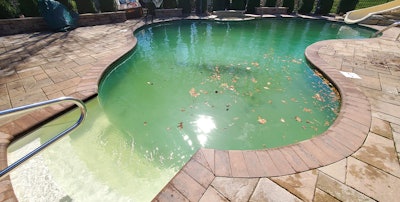
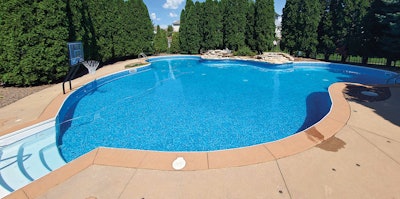
HEAVY METAL
The antibacterial and algicidal properties of metals make metallic algaecides a popular choice. The most used in the industry are copper, silver and zinc. However, all metals except for one (stainless steel) will lyse cells (disrupt cell membranes) to one extent or another, and each has a hidden punch.
Copper is vital to the survival of algae and photosynthetic bacteria (black algae), so the cells will readily absorb this metal. However, there is a Trojan Horse effect associated with the element. In significant supply, copper will interfere with the Calvin cycle, the process in photosynthesis where carbon dioxide (CO2) is converted to sugar.
No conversation about silver is complete without mentioning the oligodynamic effect. This is the biocidal effect of all heavy metals, but silver takes it to the next level. Initially creating pores in the microorganism's membrane for entry, silver unleashes its wrath, causing damage to DNA and m-RNA, denaturing ribosomes, altering energy drive, damaging the mitochondria, causing cellular dismantling, and oxidizing vital proteins. Silver is badass; they use this stuff to kill werewolves.
Zinc is another favorite due to its antibiotic properties. Initially, this mineral disrupts membrane permeability and generates hydrogen peroxide (H2O2), causing oxidation reactions. It will also interfere with the cell's ability to metabolize sugars. Ultimately, this mineral causes a thinning of the plasma membrane and slows cell division.
COAGULATION
If you know me, you already know I like alum (aluminum sulfate). But I don't use it for every green-to-clean because, in all honesty, it sometimes is just overkill. If I have zero visibility — I can't see the top tread on the ladder visibility — and the pool floor is not deep with debris, that is when I floc heavily with alum. For the same pool with a ton of leaves, branches, or household appliances, I opt to drain and fill. If I can spot the main drain, I lean toward one of the other options discussed above.
Alum is Al2(SO4)3; when put in water, it splits into aluminum(Al3+) ions and sulfate (SO42-) ions. Water is H2O. It can break into hydrogen (H+) and hydroxide (OH-) ions. The aluminum ions can combine with the hydroxide ions to form an insoluble floc called Al(OH)3. This floc will catch EVERYTHING, including phosphates floating in the water and bring it to the pool floor, and it will do it in only 12 hours. You'll have a clear pool with a slow, thorough vac-to-waste of the sludge. The challenge in alum is that it is pickier than a kid with a nose full of boogers.
To maximize the floc you get from aluminum sulfate, you must adhere to precise criteria. First, the pH — you need a level between 5.0 and 8.5 (Ruben & Hayden, Aq. Env. Chem. Metals, Ann Arbor, 1974). The pH level determines the amount of product required and the length of time it takes to floc and settle. Many alum-based products instruct users to raise the pH high, but you'll be happier with the results and the higher profit at the lower values. I bring all my pools to a pH of 7.0 before addition. The total alkalinity should be between 80 and 110 parts per million — that's the ideal range. The water temperature should be greater than 70 degrees Fahrenheit. In the case of a green-to-clean, my alum dose is between four and six pounds per 10,000 gallons. A few additional steps to this process can be found in my June 2023 article in AQUA Magazine, titled "Research Update: CYA Removal Method Confirmed."
Special Note: Pictures of the water purification technique using alum (aluminum sulfate) can be seen on the walls of the tombs of Amenophis II (died 1401 or 1397 BC ) and Ramses II (died 1213 BC)
RECESSION-PROOF
Green-to-clean REOs provide a nice counter-current of income during recessions. It is no surprise that the demand for pool service declines in times of economic crisis. However, the number of foreclosed pool homes increases. These properties are returned to the lenders and are eventually brought back to market. Banks and realtors are aware a green pool doesn't sell houses.
If you have fostered these relationships when times are good, you will reap the rewards when the economy hits the porcelain altar. Keep in mind that this is not a one-and done situation. Once these pools are returned to swimmable condition, the real estate companies will need you to stay on for regular service until the home sells. In a recession, this could be months or years. In the last recession from 2008 through 2010, my service company conducted roughly 250 swamp remediations at foreclosed or REO properties and still a decent number in the two years that followed.
DON'T UNDERCUT THE MARKET!
One of the questions I hear the most is, "How much should I charge?" My advice is always the same — as much as you can. This is not easy work. There is a skill involved. This SHOULD NOT be considered part of your routine service and included in your monthly fee. The pricing in the pool industry varies drastically by region. To ensure you are not leaving money on the table, you must do your homework and find out what your competitors charge. Determine who is charging the most, and then whatever that is, charge 10 to 15% more. There's nothing wrong with being the most expensive. It is expected that a better product comes at a higher dollar amount.
Of course, other methods exist, but I covered the most popular ones. It is essential to understand that algae remediation professionals are more than mere technicians; they are artists in their own right. They possess a deep understanding of water chemistry, filtration systems, and the intricate workings of swimming pool equipment. Like artists wielding brushes and paint, these professionals expertly combine their technical knowledge with a creative touch to breathe life back into abandoned and neglected swimming pools.












































